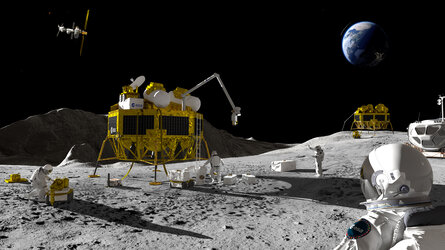Esperia Mission
23 October 2007 was an important landmark in European space history. Italian ESA astronaut Paolo Nespoli was launched to the International Space Station on the European Esperia mission aboard STS-120 Space Shuttle Discovery, which took Node 2, the first European-built module to be permanently attached to the International Space Station.
The Esperia mission was undertaken as an Italian Space Agency (ASI) flight opportunity, stemming from their agreement with NASA for the provision of 3 Multi-Purpose Logistics Modules. The cooperation with ESA led to the assignment of Paolo Nespoli to this flight and an additional agreement between ESA and ASI was signed to this effect.
A majority of Paolo’s tasks on the Esperia mission were tasks for Space Station 10A assembly mission. Paolo played a key role in the four spacewalks including the installation of Node 2. He was the key astronaut inside the Station and in direct contact with the spacewalking astronauts, coordinating their activities, as well as being involved in the spacewalk preparations such as configuring and testing spacesuits and tools, helping suit up and including airlock pressurisation.
The 16-day mission also relocated the Station's P6 truss section and deployed its solar arrays and heat dispersal radiator; deployed the heat dispersal radiators on the S1 truss; brought important supplies to the Station; exchange one ISS Expedition crewmember, and tested a new method of repairing damage to the Shuttle’s thermal protection system. As part of the Esperia mission Paolo also ran important experiments for the European scientific community as well as a number of educational activities.

Node 2 installation
Nodes are interconnecting elements between the various pressurised modules on the International Space Station, allowing the passage of astronauts and equipment and providing important resources to the other modules attached such as distribution of electrical power and thermal and environmental control.
Node 2 or ‘Harmony’ as it has now been named was developed for NASA under an ASI contract with European industry, with Thales Alenia Space as the prime contractor. Responsibility for Node 2 development was assigned to ASI. The structural design is based on that of the European-built Multi-Purpose Logistics Modules (MPLMs) and the European Columbus laboratory.
The launch of Node 2 heralds the cornerstone of European involvement in the Space Station with the launch of the Columbus laboratory following in February 2008. Node 2 was attached to the American laboratory ‘Destiny’. It acts as the attachment point of Columbus and the Japanese Kibo laboratory. MPLMs were attached to Node 2, and the Shuttle and the Japanese HTV were also be able to dock to Node 2.

P6 truss relocation
The Space Station truss is made up of 11 sections and used primarily to support the Space Station's solar arrays for power generation. The P6 truss (and solar arrays) was the first truss section launched to the Station for generation of electricity in the Station’s early configuration. This truss section was moved from its original (temporary) location to the end of the main truss on the left-hand or port side, attached to the P5 truss section, which was attached to the Station on the STS-116 mission during a spacewalk with ESA astronaut Christer Fuglesang.
Solar arrays on the main truss can rotate in more directions than they could in their temporary location. Moving P6 onto the main truss provides a more stable and improved weightless environment which is helpful for experimentation purposes.

S1 radiator deployment
When the capacity and power demands of the Station increased with the arrival of Node 2, the Columbus laboratory and the Japanese Kibo laboratory, the requirements for removing excess heat from systems and equipment also increased.
Heat dispersal radiators were deployed on the back of the S1 truss section. Before that only the central one of the three radiators was deployed. Similar radiators on the P1 (left-hand or port side) truss were deployed after the Shuttle undocked. Preparations for deployment of the radiators on the back of the P1 truss also took place during the mission.

Thermal Protection Repair Test
On Flight Day 10 a spacewalk was planned to test a new method of repairing damage to the Shuttle’s thermal protection system whilst on orbit. The spacewalking astronauts were going to test a new tile filling material and a new dispenser of this filling material. This operation was later cancelled before the mission started.
Undertake a European experiment programme
During his mission, Paolo Nespoli ran a number of European experiments for the European scientific community in the area of human physiology and biology.
Some experiments were performed on behalf of the European Space Agency and some were sponsored by the Italian Space Agency. Paolo also did a number of educational activities during the mission.
Exchange a member of the Station crew
NASA astronaut Dan Tani flew to the Space Station on the Discovery STS-120 flight. He remained on to become an Expedition 16 Flight Engineer. He replaced Expedition 15/16 Flight Engineer Clayton Anderson who arrived at on 10 June 2007 on STS-117 Space Shuttle Atlantis. Clayton returned with the STS-120 crew.

Delivery of supplies and equipment
As well as bringing some standard supplies for the crews, the Esperia mission brought equipment which will be used to outfit Node 2 as well as additional equipment that was installed during spacewalks.
The crew
NASA astronaut Dan Tani and ESA astronaut and Mission Specialist Paolo Nespoli formed part of a seven-member Shuttle crew along with NASA astronauts Pamela Melroy (Shuttle commander), George Zamka (pilot) and mission specialists Scott Parazynski, Douglas Wheelock, and Stephanie Wilson.















 Germany
Germany
 Austria
Austria
 Belgium
Belgium
 Denmark
Denmark
 Spain
Spain
 Estonia
Estonia
 Finland
Finland
 France
France
 Greece
Greece
 Hungary
Hungary
 Ireland
Ireland
 Italy
Italy
 Luxembourg
Luxembourg
 Norway
Norway
 The Netherlands
The Netherlands
 Poland
Poland
 Portugal
Portugal
 Czechia
Czechia
 Romania
Romania
 United Kingdom
United Kingdom
 Slovenia
Slovenia
 Sweden
Sweden
 Switzerland
Switzerland


























